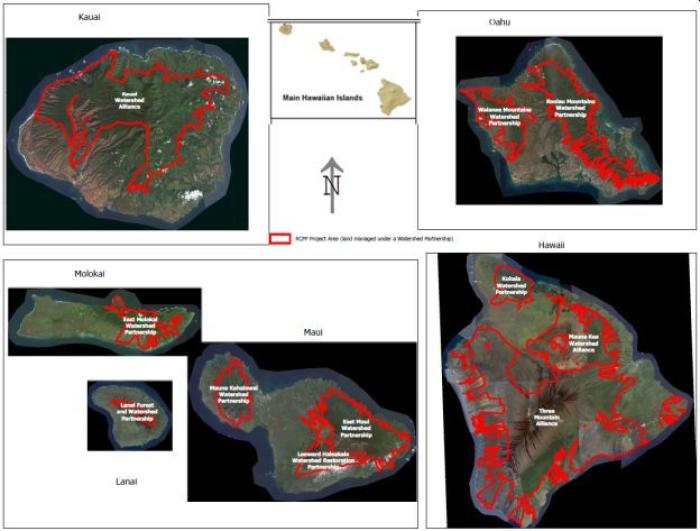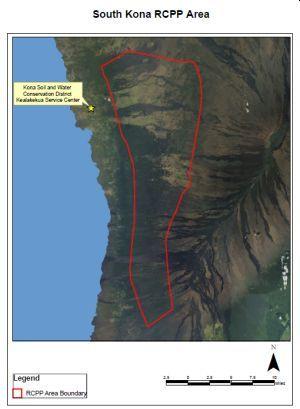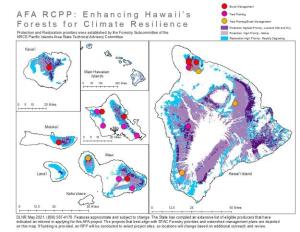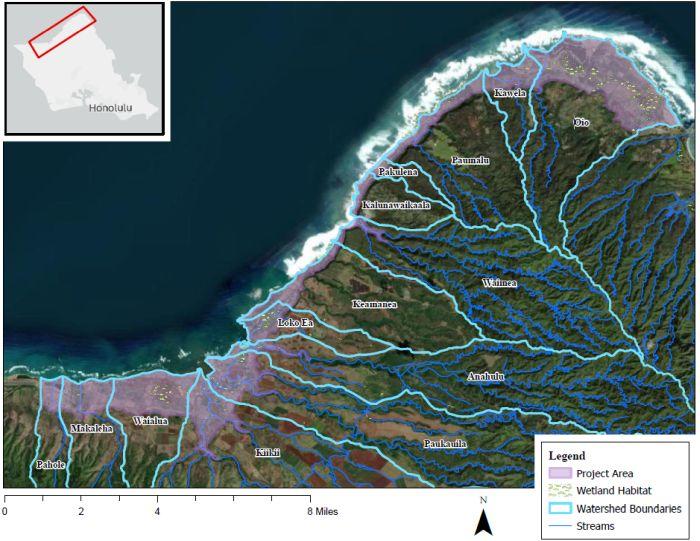
RCPP is a partner-driven approach to conservation that funds solutions to natural resource challenges on agricultural land. In the Pacific Islands Area, partners are implementing four active RCCP awarded projects.
Restore Native Forest Ecosystems for Watershed Protection and At-Risk Species Habitat Benefits (4 Projects)
- Project Lead Partner: State of Hawaii, Department of Land and Natural Resources, Division of Forestry and Wildlife
- Project Location: Hawaii, Maui, Kauai, Oahu, and Molokai
Purpose: Protect intact native forest through the control of invasive species and installation of fence to exclude ungulates to protect endangered species critical habitat. Tree planting, and monitoring are also included in this project.
Project Period: 2015 to 2023
- NRCS Funds: RCPP-EQIP FY15-18 - $2,445,728
- Producer Applications: Currently being accepted (click here for application information)

Innovation in Kona's Upland Forests

- Project Lead Partner: Kona Soil and Water Conservation District
- Project Location: South Kona, Hawaii Island
- Purpose: Promote biodiversity and habitat quality, sequester carbon, and increase groundwater recharge through increased and improved forest cover. Practices installed under this project are Tree and Shrub Site Preparation, Tree and Shrub Establishment, Brush Management, Herbaceous Weed Control, Forest Trails and Landings, and Upland Wildlife Habitat Management
Project Period: 2022 to 2026 - NRCS Funds: $1,420,000
- Producer Applications: Contact the NRCS Kealakekua Field Office (click here for application information)
Enhancing Hawaii's Forests for Climate Resilience

- Project Lead Partner: State of Hawaii, Department of Land and Natural Resources, Division of Forestry and Wildlife
- Project Location: Hawaii
- Purpose: Forest restoration on land with the highest potential carbon sequestration, groundwater recharge, and benefit for important plant and wildlife species. Practices installed under this project are Tree and Shrub Site Preparation, Tree and Shrub Establishment, Brush Management, Herbaceous Weed Control, Upland Wildlife Habitat Management, and Restoration of Rare or Declining Natural Communities.
- Project Period: 2022 to 2026
- NRCS Funds: $4,519,516
- Producer Applications:
O'ahu North Shore Working Wetlands
Project Lead Partner: O’ahu Resource Conservation and Development Council
Project Location: O’ahu’s North Shore
Purpose: This project will enhance wetland management of lowland agricultural operations on Oahu’s North Shore to sustain indigenous cropping systems and critical habitat for endangered Hawaiian waterbirds. Practices implemented will enhance water quality and wildlife habitat using Traditional Ecological Knowledge (TEK) and biocultural restoration techniques; remove invasive species and establish native plants in wetland and nearshore areas; restore wetland function through improved water control and loi shoreline stabilization; increase climate resiliency through use of climate smart practices that improve soil health, reduce greenhouse gas emissions, and sustain crop productivity; reduce erosion and improve soil health (increase soil carbon) on upland areas adjacent to wetlands; and inform adaptations to practice standards and payment structures needed to address resource concerns on indigenous agriculture systems.
Project Period: 2023 to 2027
NRCS Funds: $2,340,105
Producer Applications: Contact the NRCS Oahu Field Office

Contact
Nicholas Saumweber
Assistant Director for Programs
Phone: (808) 600-2959
Email: Nicholas.Saumweber@usda.gov
Ready to get started?
Contact your local service center to start your application.
How to Get Assistance
Do you farm or ranch and want to make improvements to the land that you own or lease?
Natural Resources Conservation Service offers technical and financial assistance to help farmers, ranchers and forest landowners.

To get started with NRCS, we recommend you stop by your local NRCS field office. We’ll discuss your vision for your land.
NRCS provides landowners with free technical assistance, or advice, for their land. Common technical assistance includes: resource assessment, practice design and resource monitoring. Your conservation planner will help you determine if financial assistance is right for you.
We’ll walk you through the application process. To get started on applying for financial assistance, we’ll work with you:
- To fill out an AD 1026, which ensures a conservation plan is in place before lands with highly erodible soils are farmed. It also ensures that identified wetland areas are protected.
- To meet other eligibility certifications.
Once complete, we’ll work with you on the application, or CPA 1200.
Applications for most programs are accepted on a continuous basis, but they’re considered for funding in different ranking periods. Be sure to ask your local NRCS district conservationist about the deadline for the ranking period to ensure you turn in your application in time.
As part of the application process, we’ll check to see if you are eligible. To do this, you’ll need to bring:
- An official tax ID (Social Security number or an employer ID)
- A property deed or lease agreement to show you have control of the property; and
- A farm number.
If you don’t have a farm number, you can get one from USDA’s Farm Service Agency. Typically, the local FSA office is located in the same building as the local NRCS office. You only need a farm number if you’re interested in financial assistance.
NRCS will take a look at the applications and rank them according to local resource concerns, the amount of conservation benefits the work will provide and the needs of applicants. View Application Ranking Dates by State.
If you’re selected, you can choose whether to sign the contract for the work to be done.
Once you sign the contract, you’ll be provided standards and specifications for completing the practice or practices, and then you will have a specified amount of time to implement. Once the work is implemented and inspected, you’ll be paid the rate of compensation for the work if it meets NRCS standards and specifications.

